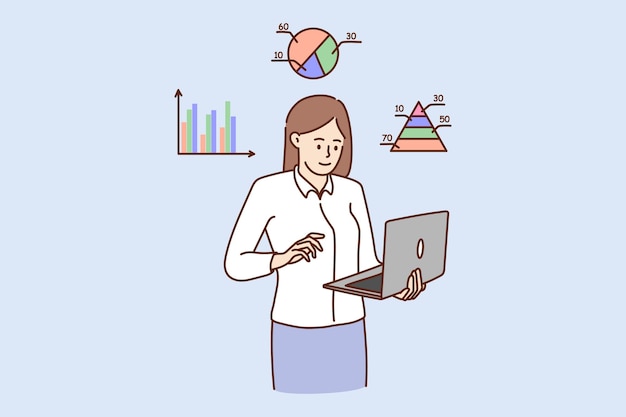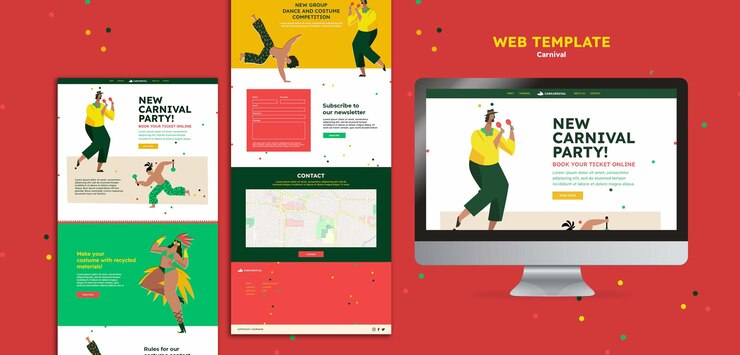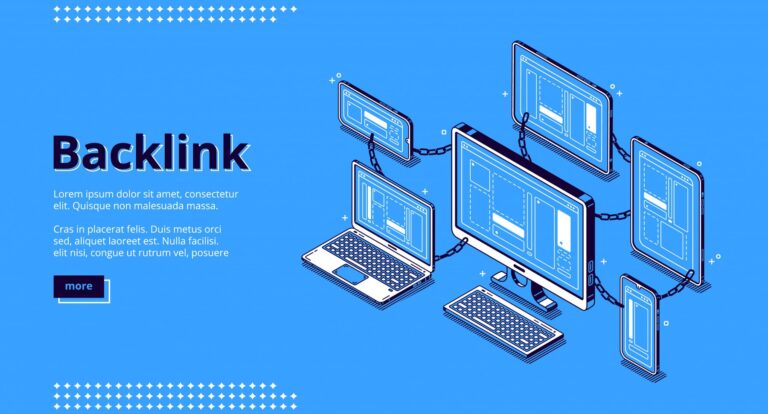If you own a business and haven’t focused on digital marketing, you’re losing out on a big opportunity. Let me explain what digital marketing can do to benefit your business.
Understanding this can help you figure out where to begin learning these skills and which areas to focus on first and possibly selecting the right person to handle your digital marketing.
We’ll cover social media, SEO, email, and more channels. We’ll also give you tips on how to get started with digital marketing, even if you have a small budget. The digital world provides many opportunities to promote your business in new ways. Our goal is to make it less intimidating so you can harness the power of digital marketing. With some knowledge, you’ll be ready to create an effective digital strategy.
Introduction
Digital marketing refers to promoting products or services using digital technologies, mainly on the Internet, including mobile phones, display advertising, and other digital mediums. In today’s world, digital marketing has transformed how companies build relationships and interact with customers.
Traditional marketing methods like print ads, billboards, and TV commercials don’t cut it anymore. People spend vast chunks of their days on mobile devices, laptops, and other digital platforms. They search for businesses online, interact with companies through social media, and make purchases on e-commerce sites.
To reach your target audience, you need to meet them where they are – in the digital world.
Some of the Major Channels in Digital Marketing Include:
Search Engine Optimization (SEO)
Optimizing your web content so your business ranks higher in organic search results.
Pay-Per-Click (PPC) Advertising
Use words related to your business throughout your website. This helps people find you when they search online.
Social Media Marketing
Engaging your audience on social platforms like Facebook, Instagram, and Twitter. You can promote your business, build brand awareness, and foster customer relationships through social media.
Email Marketing
Sending promotional emails to your subscriber list. Email is still one of the most effective digital marketing channels.
Content Marketing
Creating and distributing valuable content like blog posts, videos, and social media updates to attract new customers and build trust in your brand.
The key benefits of digital marketing are that it’s affordable, targeted, trackable, and can provide an excellent return on investment. The possibilities are endless, so dive in and unlock the power of digital marketing for your business!
1. Building Your Online Presence
A solid online presence is essential for any modern business. Your website is your digital storefront, so you’ll want to ensure it represents your brand well and provides an excellent user experience. Focus on:
Make Your Website Easy to Use
Use a simple layout, good pictures, and clear language to explain what you do. Also, make sure your site works well on phones.
Get Found on Google
Use words related to your business throughout your website. This helps people find you when they search online.
Share Interesting Stuff
Post blogs, videos, and photos on your website and social media. Make them helpful or inspiring. Keep updating your content to keep people interested.
Be Active on Social Media
Use Facebook, Instagram, and LinkedIn to connect with people. Post regularly, talk to your followers, and join conversations. This helps more people know about you and your business.
In today’s digital world, you’re missing out on a massive opportunity if people need help finding you online. Investing in your online presence through a well-designed website, strong SEO, valuable content, and active social media profiles is critical to unlocking the power of digital marketing for your business success. You’ll gain more visibility, traffic, and customers with the right strategy and consistency. So what are you waiting for? Get out there and start building your digital brand!
2. Reaching your target audience

A successful digital marketing campaign requires reaching the right people—your target audience. This includes your ideal customers, the people most likely to buy your products or services. You can tailor your marketing to directly speak to their needs and interests by identifying and targeting your key audience.
Social media platforms like Facebook, Instagram, and LinkedIn offer advanced targeting options to connect with your audience. You can target by location, demographics, interests, and behaviors. Promoting content and ads to the right groups will increase engagement and conversions. For example, if you sell gardening tools, target those interested in gardening, homesteading, and outdoor activities.
Build an Email List
Email marketing lets you speak directly to your customers and keep your business in mind. Collecting email addresses through your website, social media, and in-person events gives you a valuable way to reach your target audience. Send newsletters, special offers, tips, and resources to provide value to subscribers and promote your products or services.
Targeted Online Ads
With platforms like Google Ads, Facebook Ads, and LinkedIn Ads, you can create customized ads targeted to your audience. Options include targeting by location, demographics, interests, behaviors, and more. A/B tests different ad variations for the best results to see which performs better. Track key metrics like impressions, clicks, and conversions to optimize your campaigns.
Refining your targeting and personalizing the customer experience is critical to digital marketing success. Focus on providing value for your audience through helpful content and resources. Build trust and loyalty by understanding their needs and interests so you can connect meaningfully. With time and testing, you’ll gain insights into what resonates most with your customers and how to improve your targeting for the best results.
3. Engaging and Keeping Customers

You need to engage with your customers meaningfully to build solid and long-lasting relationships with your customers. Digital marketing tools make this more accessible than ever before.
Make Their Experience Great
Use your website, social media, and email marketing to create helpful content and resources for your customers. How-to guides, FAQs, video tutorials, and blog posts add value by educating them. When they have a positive experience with your brand, they’ll return.
Could you get to Know Them?
Analyze data from your website and social platforms to understand customers’ needs, interests, and behaviors. See what they’re clicking on, how long they spend on pages, what they share, and more. Then, they use that information to personalize their experience. For example, send targeted emails with content you know they’ll appreciate based on browsing history.
Build Trust and Loyalty
Be transparent in your business practices and responsive to your customers. Answer questions and concerns quickly via social media, email, and phone. Admit when you make a mistake and fix the issue promptly. Loyal, long-term customers are the lifeblood of any company, so make customer service a top priority.
Stay in Touch
Use email newsletters, social media, and retargeting ads to keep your brand in front of customers and stay on their radar. But do what is necessary – aim for 2-4 monthly emails and social media posts each week. Provide a mix of content, including blog updates, promotions, tips, and company news. Make it relevant and valuable so they look forward to hearing from you.
Keeping your customers engaged with unique experiences, targeted outreach, transparent communication, and consistent follow-up is the key to building loyalty and turning one-time shoppers into lifelong brand fans. Focus on relationships over transactions, and your business will thrive.
4. How Can You Drive Sales and Improve Conversions?

Optimizing your website or app for conversions (CRO) is paramount in today’s digital environment. Implementing effective CRO techniques can significantly enhance user engagement and drive business success. Here’s a detailed look at each method:
User Research & Testing
User testing: This involves observing how users interact with your website or app to identify pain points and areas for improvement. Tools like Hotjar, Crazy Egg, and UserTesting.com can provide valuable insights.
A/B testing: Experimenting with different versions of website elements such as headlines, CTAs, and layouts helps determine which variations perform best regarding conversion rates.
Heatmaps & session recordings: Visualizing user behavior through heatmaps and session recordings helps understand user preferences, clicks, scrolls, and areas of high engagement or abandonment.
For example, Imagine a shop owner meticulously observing customer behavior to identify which areas of the store attract the most attention and which need improvement. Similarly, a website owner analyzes user interactions to optimize the user experience.
Website & Content Optimization
Clear value proposition: Communicating the benefits of your product or service upfront helps visitors understand its value proposition quickly.
Compelling headlines & CTAs: Using attention-grabbing copy for headlines and CTAs encourages users to take desired actions, such as purchasing or signing up.
High-quality visuals: Incorporating relevant images, videos, and infographics enhances user engagement and conveys information more effectively.
Mobile-first design: With most internet users browsing on mobile devices, ensuring a seamless experience across all devices, especially smartphones, is essential.
Fast loading speed: Optimizing website performance for fast loading speeds is crucial to prevent user frustration and abandonment.
For example, Similar to how an attractive storefront display immediately communicates the offerings of a physical store, a visually appealing website homepage effectively communicates the value proposition to visitors.
Personalization & Targeting
Personalized content & offers: Tailoring content and offers based on user preferences and behavior helps create a customized experience that resonates with users.
Behavioral targeting: Showing targeted ads and messages to specific user segments based on their browsing history or demographics increases the relevance of marketing efforts.
Retargeting campaigns: Reminding users of visited sites with relevant ads on other platforms helps re-engage them and encourage conversions.
For example, Just as a store clerk recommends products based on a customer’s preferences and past purchases, a website can personalize product recommendations based on user behavior.
Trust & Social Proof:
Customer testimonials & reviews: Showcasing positive feedback from satisfied customers helps build trust and credibility.
Security badges & certifications: Displaying trust signals like SSL certificates and industry accreditations reassure users about the security of their information.
Case studies & success stories: Highlighting real-life success stories and case studies demonstrate the effectiveness and reliability of your product or service.
For example, Similar to how word-of-mouth recommendations from friends influence purchasing decisions, positive customer testimonials and reviews influence online purchasing decisions.
Call to Action (CTAs):
Clear and concise: Using straightforward language in CTAs directs users on the action they should take next, such as “Buy Now” or “Sign Up.”
Prominent placement: Ensuring CTAs are prominently displayed and easily visible encourages users to act without friction.
A/B test different CTA variations: Experimenting with different CTA variations helps determine which resonates best with your audience and drives higher conversion rates.
For example, Just as a salesperson guides customers to the checkout counter with clear signage in a physical store, a well-placed CTA directs website visitors to the desired action.
User Experience (UX) Optimization:
Easy navigation: Simplifying site navigation ensures users can find what they’re looking for quickly and easily.
Intuitive design: Designing the website with user-friendliness in mind enhances the overall user experience and encourages engagement.
Reduce friction: Minimizing obstacles in the conversion process, such as unnecessary form fields or complex checkout processes, streamlines the user journey.
For example, Similar to how a physical store organizes products logically for easy access, a website with intuitive navigation helps users find desired information effortlessly.
Analytics & Data Tracking
Track critical metrics: Monitoring essential data points such as conversion rates, bounce rates, and user engagement provides insights into the effectiveness of your CRO efforts.
Analyze user behavior: Understanding how users interact with your website through data analysis helps identify areas for improvement and optimization.
Use data to inform decisions: Making data-driven decisions based on analytics insights ensures your CRO strategies are practical and aligned with user preferences.
For example, Similar to how a store owner analyzes sales data and customer traffic to optimize store layout and product offerings, analyzing website analytics helps maximize website performance and user experience.
Remember, implementing these CRO techniques is an ongoing process. Continuously testing, analyzing, and refining your strategies based on data and user feedback is essential to maximize conversion rates effectively.
5. Measuring Success and Getting the Most out of Your Efforts

Once your digital marketing campaign runs, it’s time to track its performance. Key Performance Indicators, or KPIs, are metrics that help determine whether you’re achieving your goals. Some important KPIs to monitor include:
Website & Social Media Traffic Analysis
Tools: Google Analytics, Facebook Insights, Twitter Analytics, etc.
- Action: Regularly monitor key metrics like page views, session duration, bounce rate, and audience demographics.
- How-to: Set up tracking codes on your website and social media platforms. Analyze reports to identify high-performing pages, popular topics, and audience segments.
- Advanced Tip: Segment your audience by demographics and interests to understand their engagement with specific content.
Conversion Tracking & Measurement
Tools: Google Analytics, Facebook Pixel, Hotjar, etc.
- Action: Set up conversion tracking to measure actions like form submissions, purchases, or downloads.
- How-to: Install conversion tracking pixels on your website and landing pages. Use tools like Google Analytics or heatmaps to analyze user behavior leading to conversions.
- Advanced Tip: A/B tests different website elements (CTAs, headlines, page layouts) to see which drives higher conversions.
ROI Calculation & Analysis
Tools: Marketing attribution platforms, spreadsheets
- Action: Calculate your marketing campaign’s return on investment (ROI).
- How-to: Track campaign costs (ad spend, content creation, staff time) and revenue generated. Use formulas or dedicated platforms to calculate ROI and identify profitable campaigns.
- Advanced Tip: Segment ROI by campaign type, channel, or audience segment for deeper insights.
Customer Engagement Analysis
Tools: Social media analytics platforms, sentiment analysis tools
- Action: Monitor likes, comments, shares, and mentions across your social media channels.
- How-to: Track engagement metrics and analyze trending topics, popular content formats, and audience sentiment. Use sentiment analysis tools to understand overall brand perception.
- Advanced Tip: Respond to comments and messages promptly to foster positive relationships with your audience.
Remember: Optimization is an ongoing process. Use these tools and tactics to continuously monitor, analyze, and adjust your digital marketing strategies for maximum impact.
Bonus Tip: Utilize automation tools to streamline data collection and analysis, freeing up time for strategic decision-making.
Continuously optimizing and improving your digital marketing efforts will lead to the best results over the long run. Monitor your key metrics regularly and make minor tweaks and changes based on what the data tells you. With time and practice, you’ll better attract qualified leads and turn them into happy customers.
6. Staying Ahead in the Digital World

To stay competitive in today’s digital landscape, you must keep up with the latest trends and technologies. Things move fast, so make it a priority to learn and improve your digital marketing skills continuously.
Keep Learning
Take online courses to strengthen your content creation, social media advertising, and analytics knowledge. Check out free resources from Google, Facebook, and HubSpot to stay up-to-date with changes to their platforms. Follow industry leaders and subscribe to blogs like Moz, Search Engine Land, and Marketing Land to get insights into the latest strategies.
Adapt to Change
Digital marketing is constantly evolving. Be willing to experiment with new platforms, content formats, and emerging technologies. For example, live videos on social media, chatbots, and personalized content are tremendous opportunities. Find ways to incorporate trends that align with your business goals and audience needs. At the same time, don’t abandon strategies that are still working. Optimize your current efforts while testing new approaches.
Look Ahead
Artificial intelligence, virtual reality, and voice search are just a few technologies that will shape digital marketing in the future. Start thinking now about how you can leverage these innovations. For instance, focus on optimizing voice search using conversational content and keywords. Create immersive brand experiences through virtual reality. Use AI and machine learning to personalize interactions and gain data-driven insights.
Maintaining an open and curious mindset is the key to staying ahead in the digital world. While it may feel overwhelming, focus on continuous learning and small, consistent improvements. With hard work and persistence, you can master digital marketing and grow your business meaningfully.
Conclusion: What Digital Marketing Can Do for Your Business
Digital marketing has come a long way and now offers businesses more opportunities to connect with customers and grow. By understanding the significant channels – social media, content marketing, email marketing, SEO, and PPC – you’ve taken the first step to unlocking the power of digital for your business.
Use Social Platforms
Leverage the social platforms where your target audience spends the most time. Post regularly, engage with followers, and build community.
Create Content
Create blog posts, videos, podcasts, and other content that provide value to your audience. Content is crucial in establishing your business as an authority in your industry.
Build an Email List
Build an email list and send regular newsletters with helpful tips and promotions. Email marketing has one of the highest returns on investment.
Optimize your Website
Optimize your website for search engines like Google so more people can find you. Use keywords, internal linking, and fast page load times.
Run PPC Ads
Run pay-per-click ads on search engines and social media to increase traffic and brand awareness. Start with a small budget and optimize based on results.
The key is to start small and build up over time. Pick one or two channels to focus on, set measurable goals, and track your key metrics to see what’s working. You can then scale up the effective strategies. Digital marketing does require an investment of both time and money, but the potential benefits to your business are huge.
With some education and experimentation, you’ll be unlocking the power of digital marketing in no time. Your customers are out there; you have to reach them. Keep learning, keep optimizing, and keep growing your online presence. The future of marketing is digital, so take advantage of all it has to offer your business today. Success awaits!
Read about the top SEO agency in Singapore to learn more.








